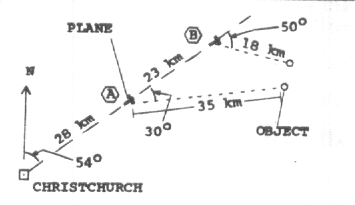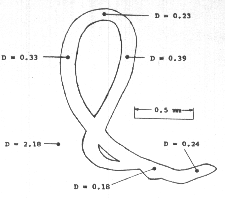Bruce Maccabee : Applied Optics, vol. 18, n° 15, pp. 2527-28,
: Applied Optics, vol. 18, n° 15, pp. 2527-28,
 : Applied Optics, vol. 18, n° 15, pp. 2527-28,
: Applied Optics, vol. 18, n° 15, pp. 2527-28, U.S. Naval Surface Weapons Center, White Oak, Silver Spring, Maryland 20910.
Reçu le . 0003-6935/79/152527-02$00.50/0. © 1979 Optical Society of America.
Ceci est un rapport sur les propriétés photométriques de base d'un objet non identifié [1] qui fut vu et photographié depuis un avion à au large de la côte est de l'Ile Sud de Nouvelle Zélande entre 2 h 19 et 2 h 33, Heure d'Eté locale le 31 décembre 1978. The photometric brightness of the object has been estimated from density measurements of images recorded on 16-mm color-reversal film in combination with the appropriate photometric equation and with distance measurements made by the airplane radar [2]. The object was a bright white-yellow and had a luminous intensity well over 100,000 cd.

The object was observed by four witnesses as well as the cameraman, and it was detected continuously by the airplane radar during a portion of the time that it was seen visually. The radar detection range decreased from ~35 km to ~18 km as the plane flew northeast out of Christchurch, New Zealand. Unfortunately, exact radar distances that correspond to specific images in the film cannot be determined because the cameraman was not keeping track of the times when the various segments of the film were obtained. However, it is possible to bracket the radar distances that correspond to the section of film under consideration here.
During the time that the object was detected on radar, the plane was climbing on a 54° heading out of Christchurch, and the ground speed increased from ~315 km/h to ~370 km/h. Estimated positions of the plane and the object are illustrated in Fig. 1. The object was first detected on radar at point A on the figure, and it was continuously on radar until the azimuthal angle reached about 50°, the limit of the radar scan, at point B. During that time (about 4 min) the plane traveled about 23 km, and the object apparently traveled about 5 km. The witnesses had the impression that the object was at least as high as the top of the scattered cloud layer (about 800 m) and that for a period of time it actually paced the aircraft. Since it was not detected by the Christchurch radar [2], it was either a weak reflector of 50-cm waves or below about 1 km in altitude (or both).
The photographic equipment consisted of a Bolex EBM electric 16-mm movie camera with a 100-mm, f/1.9 zoom lens that was used at full aperture and full zoom (except for a short section of wide-angle photography which shows a meter inside the airplane). The camera was operated at 10 frames/sec. Fujicolor type 8425 color-reversal film with an ASA speed of 400 was used. The camera was hand held (a tripod was found inconvenient to use on the flight deck of the aircraft), and consequently most images are smeared. Microdensitometer scans have shown that the images which are small and not streaked are often highly overexposed, with the film having a transmission that approaches the transmission of the clear film leader. For such highly overexposed images it is difficult to estimate the illuminance on the film plane. On the other hand, smeared images are somewhat less overexposed and allow better estimates of the film-plane illuminance. With less exposure it is possible to use the published characteristic curves (film density vs exposure) to estimate the luminous flux which reached the film plane during the frame time. With an estimate of image illuminance and a measurement of the image area, it is possible to estimate the flux (lumens) which reached the film and, with the following equation, to estimate the intensity of the source:
E*A*R^2
I = ------------- exp(3.9R/V), (1)
T*Al
where I is in lumens per steradian (i.e., candelas), E is the film-plane illuminance in lumens per square meter, A is the image area, R is the distance to the source, T is the lens transmission (assumed to be 80%), and Al =(PI*D^2)/4 is the area of the lens aperture. For f/1.9, D = 10 cm/1.9 = 5.26 cm. The visibility V, estimated from ground-level data, was about 70 km.

Of particular interest is a single-frame image smear obtained when the radar range R was between 18 km and 35 km. This image (Fig. 2) ranges in color from bright yellow in the sides of the loop to white-yellow at the top and bottom of the loop. Neutral densities (density = -log10 of the film transmission) range from 0.4 down to 0.2, and that of the clear leader is about 0.12. The densities for the three colors (red, green, blue) in the portions of the film which have not been exposed (e.g., the black background) lie in the range 2.1-2.3. Published film characteristics [3] indicate that the normal density range is from ~0.10 to ~2.3-2.7 for the three colors, and that the speed-point density for the film is about 0.90 since the upper density range of the film under study here is somewhat below the normal density, the speed point may also be somewhat low. A reasonable estimate is that the speed-point density for this film might be as low as 0.80.
According to the ANSI standard, ASA 400 film reaches its speed-point density when exposed by a flux of about 0.025 lm-sec/m^2 (0.025 lux-sec). For a 0.044-sec exposure this becomes 0.57 lm/m^2. The measured loop image densities differ from the speed-point densitv by 0.4-0.6 density units, indicating that the image illuminance was 10^0.4 = 2.5 to 10^0.6 = 4 times the speed-point illuminance. (Note that the relationship between density and exposure is somewhat less than linear to nearly linear in this region of the characteristic curves.) Accepting a conservativve estimate of three times the speed-point illuminance, Ei = 1.7 lm/m^2. The total image area for which the density is 0.4 or less lexposure is three times the speed-point value or greater) is about 0.003 cm^2. Assuming a radar range of only 18,000 m, Eq. (1) yields about 260,000 cd. For R = 35 km, Eq. (1) yields about 2.5 x 10^6 cd. For comparison, a relatively high-efficiency 10.000W incandescent bulb radiates about 330,000 lms into 4Pi sr, which corresponds to ahout 26,000 cd [4].
A characteristic source size may be estimated from the lens focal length and the widths of the streaked image. The angular width of the narrow horizontal sections is about 0.00065 rad, and that of the wider vertical sections is about 0.001 rad. Assuming a stationary object (streak due only to camera motion), these angular sizes would be consistent with a non-circular source which, at 18 km. would be ~12 m high X ~18 m wide. At 35 km the dimensions would be about twice those given.
It is not the intent of this Letter to offer an explanation for the unusual bright source. However, one may note that the brightness (over 100,000 cd), the size (on the order of 20 m or more), and the duration (it was seen for over 12 min [5]) place severe requirements on a conventional phenomenon such as glowing plasma or ball lightning.
Références :